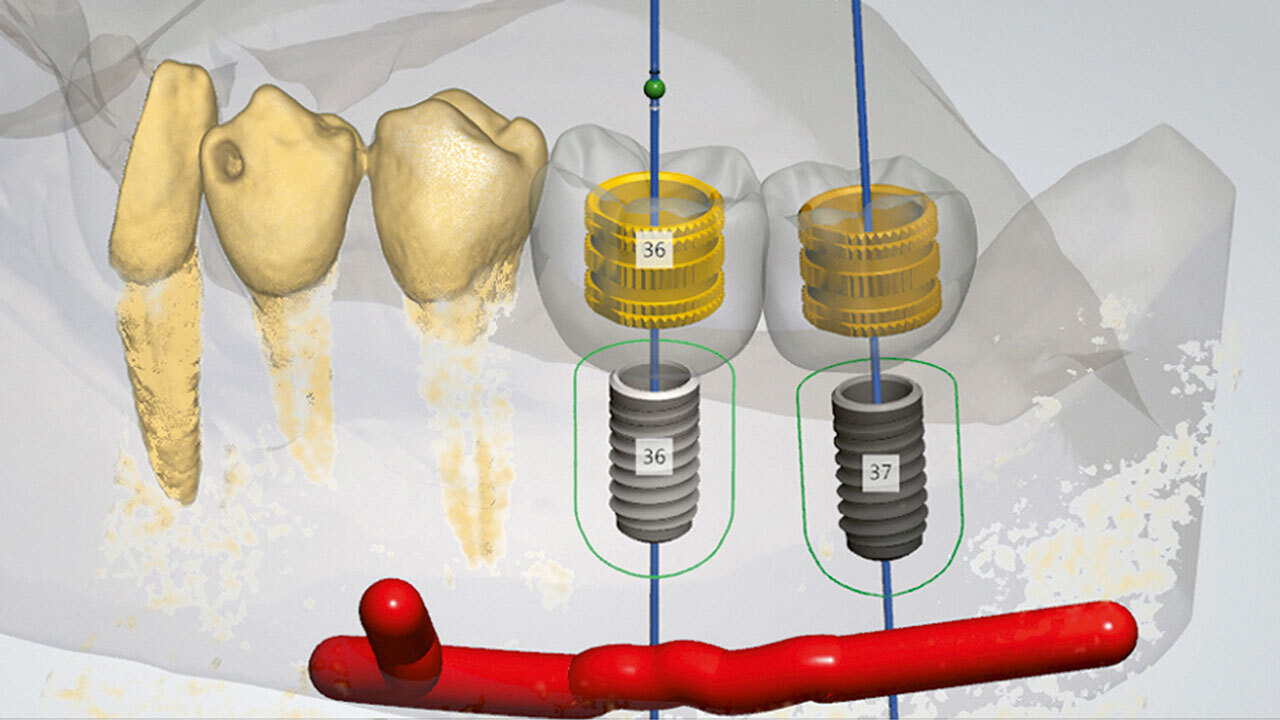Journal of Craniomandibular Function, 3/2024
Case ReportPages 243-261, Language: English, GermanUrich, Julia / Schweiger, Josef / Pho Duc, Jean-Marc / Schubert, OliverOsteoarthritis of the temporomandibular joint (TMJ) is a degenerative joint disease that leads to morphological and functional changes in the TMJ. Clinically, it can be associated with crepitation, pain, and functional limitations. The following article describes a patient case who presented with the above. First, the function-specific diagnostic cascade is explained. Based on these examinations, the diagnosis of temporomandibular disorder (TMD) with the components of occlusopathy, myopathy, and arthropathy was performed. Initially, a conservative treatment approach was chosen, which led to pain elimination. A follow-up examination 3 months later revealed a severely altered occlusion with only one single static occlusal contact, necessitating further measures. The focus was on slowing down the degenerative changes in the TMJ, eliminating the inflammation of the left TMJ, and restoring functional occlusion. These treatment goals were achieved only through the additional use of a tooth-colored CAD/CAM occlusal splint. For this purpose, the jaw relation was digitally transferred from the conventional centric splint to the CAD/CAM occlusal splint. The patient case is an example of a combined digital-conservative treatment approach for complex TMD cases.
Keywords: osteoarthritis, TMJ effusion, function-specific diagnostic cascade, conservative treatment, tooth-colored fully anatomical CAD/CAM occlusal splint, digital transfer of the jaw relation
Deutsche Zahnärztliche Zeitschrift, 3/2024
GesellschaftPages 216, Language: GermanEdelhoff, Daniel / Beuer, Florian / Güth, Jan-Frederik / Schubert, Oliver / DGProNachruf der Deutschen Gesellschaft für Prothetische Zahnmedizin und Biomaterialien e. V. (DGPro)QZ - Quintessenz Zahntechnik, 12/2024
WissenschaftPages 1168-1177, Language: German, EnglishLauer, Johannes R. / Horn, Max / Schröder, Timo / Langer, Lukas / Schweiger, Josef / Trimpl, Johannes / Erdelt, Kurt / Schubert, Oliver / Schlick, Georg / Güth, Jan-Frederick / Seidel, Christian
Multi-material additive manufacturing has the potential to produce gold-containing telescopic crowns cost-effectively and thus counteract the shortage of skilled workers and rising gold prices. New processes are being developed, with initial process qualification tests showing promising results.
QZ - Quintessenz Zahntechnik, 9/2023
InnovationPages 808-817, Language: GermanHorn, Max / Schweiger, Josef / Schröder, Timo / Langer, Lukas / Trimpl, Johannes / Erdelt, Kurt / Schubert, Oliver / Güth, Jan-Frederik / Seidel, ChristianBeschreibung der additiven Multimaterialfertigung mithilfe von Laser-StrahlschmelzenMithilfe der additiven Multimaterialfertigung können aus verschiedenen Legierungen bestehende Teile in digitalen Prozessketten gefertigt werden. In dem Beitrag wird die Anwendbarkeit der Fertigungstechnologie für die Dentalbranche anhand zweier Applikationen gezeigt und bewertet.
Keywords: 3-D-Druck, additive Fertigung, Multimaterialfertigung, Doppelkronen, Implantate
The International Journal of Prosthodontics, 3/2023
DOI: 10.11607/ijp.7765, PubMed ID (PMID): 36288491Pages 253-261, Language: EnglishEdelhoff, Daniel / Liebermann, Anja / Schubert, Oliver / Güth, Jan-FrederikPurpose: To analyze the clinical performance of two-wing–retained resin-bonded fixed dental prostheses (RBFDPs) after 5 years of clinical use with respect to technical and biologic complications, as well as survival and success rates.
Materials and Methods: RBFDPs were fabricated from 3Y-TZP zirconia layered by hand (Lava Frame veneered with Lava Ceram; 3M ESPE) or metal (Remanium Star, Dentaurum; layered with Reflex, Wieland). The primary endpoints were debonding and fracture. The secondary endpoints (marginal integrity, marginal discoloration, abrasion of antagonist dentition, patient satisfaction, Gingival Index, and side effects) were evaluated at baseline and after 5 years. Survival and success rates were calculated using the Kaplan- Meier method. Log-rank test was used to compare the survival and success rates of the different materials.
Results: The mean observation time was 6 years and 10 months. The estimated cumulative success rate after 5 years was 88.9% ± 10% for metal-supported and 33% ± 16% for all-ceramic two-wing RBFDPs. After conversion into one-wing RBFDPs, the survival rate was 100% in both groups. Debonding of one of the two wings was the major complication. One zirconia framework fracture occurred. Metal-based twowing RBFDPs showed a significantly higher success rate, but lower esthetic evaluation.
Conclusion: Due to a reduction in technical complication rate and less invasiveness, one-wing RBFDPs should be preferred over two-wing RBFDPs whenever possible.
International Journal of Computerized Dentistry, 2/2023
ScienceDOI: 10.3290/j.ijcd.b3762733, PubMed ID (PMID): 36607264Pages 149-158, Language: English, GermanSchubert, Oliver / Graf, Tobias / Schweiger, Josef / Güth, Jan-Frederik / Sciuk, Thomas / Erdelt, Kurt-JürgenAim: The CAM of esthetically pleasing monolithic dental restorations presents with specific challenges. One vital parameter to consider is the translucency of the materials. Previous studies have proven a correlation between translucency and material thickness for various all-ceramic materials. The aim of the present study was to assess and define the relationship between thickness and translucency in modern resin-based restorative materials.
Materials and methods: Specimens fabricated from two resin nano-ceramics (Cerasmart, Lava Ultimate), a polymer-infiltrated ceramic network (Vita Enamic), and a polymethyl methacrylate (Telio CAD) were examined, representing these different material classes. For each material, 12 specimens (n = 12) were fabricated in five thicknesses (0.4, 0.7, 1.0, 1.3, and 1.6 mm; N = 240). The translucency was measured with a spectrophotometer. The total light transmittance for each specimen was calculated applying specialized software. Regression curves were fitted to the results and their coefficient of determination (R2) fit was determined.
Results: Logarithmic regression curves showed the best R2 approximation (Cerasmart: R2 = 0.994; Vita Enamic: R2 = 0.978; Lava Ultimate: R2 = 0.997; Telio CAD: R2 = 0.997) to the light transmission values.
Conclusions: The results of the present study indicate that the translucency of resin-based materials can be calculated using a mathematic approach to estimate their optical behavior. Cerasmart, Lava Ultimate, Vita Enamic, and Telio CAD exhibit a logarithmic relationship between material thickness and translucency. By determining material-specific coefficients for this logarithmic function, the resulting translucency can be computed for any given material thickness.
Keywords: hybrid materials, PMMA, polymer-infiltrated ceramic network, resin nano-ceramics, translucency, translucency equation, mathematic analysis, CAD/CAM, digital workflow
Implantologie, 1/2023
Pages 63-76, Language: GermanGraf, Tobias / Schubert, Oliver / Erdelt, Kurt / Kraus, Veronika / Edelhoff, Daniel / Stimmelmayr, MichaelEine retrospektive klinische Untersuchung von implantatgetragenen Restaurationen in zahnlosen Kiefern nach bis zu 10 JahrenImplantatgetragener Zahnersatz bei zahnlosen Patienten kann herausnehmbar − mit unterschiedlichsten Verankerungselementen − oder festsitzend gestaltet werden. Art und Umfang der langfristig zu erwartenden Komplikationen beeinflussen entscheidend die Therapieform. Um diese abzuschätzen, wurden 14 implantatgetragene festsitzende Versorgungen (FZE) mit 50 herausnehmbaren (HZE) über einen Nachbeobachtungszeitraum von bis zu 10 Jahren nachuntersucht. Es wurden technische (Implantat und Abutment betreffend), biologische (Knochen und Weichgewebe betreffend) und prothetische (Suprakonstruktion betreffend) Komplikationen dokumentiert sowie mittels deskriptiver Statistik und Breslow-Tests statistisch ausgewertet (p < 0,05). Von den 328 gesetzten Implantaten mussten zwei Implantate nach 3,9 und 5,8 Jahren entfernt werden. Alle Suprakonstruktionen waren bis zur Nachuntersuchung in situ. Die durchschnittliche Komplikationsrate betrug 0,24 pro Restauration und Jahr für FZEs bzw. 0,37 für HZEs. Beim Vergleich von FZE und HZE zeigten sich über 10 Jahre keine signifikanten Unterschiede hinsichtlich des Auftretens biologischer und prothetischer Komplikationen. Insgesamt traten prothetische Komplikationen etwa vier- bis fünfmal häufiger auf als biologische.
Manuskripteingang: 08.01.2023, Annahme: 02.02.2023
Originalpublikation: Graf et al. „Up to 10-Year Incidence of Complications in Fixed vs Removable Implant-Supported Restorations for Edentulous Arches.“ (Int J Prosthodont 2022;35:269−277).
Keywords: dentale Implantate, festsitzender Zahnersatz, herausnehmbarer Zahnersatz, implantatgetragener Zahnersatz, Komplikationen, Komplikationsrate, Locatoren, Stege, Teleskope, zahnloser Kiefer
The International Journal of Prosthodontics, 4/2022
DOI: 10.11607/ijp.7563Pages 545-552, Language: EnglishSchubert, Oliver / Gaissmaier, Michael / Graf, Tobias / Schweiger, Josef / Güth, Jan-FrederikPurpose: To evaluate the shear bond strength (SBS) of different digital veneering techniques for zirconia and to critically discuss its suitability for application in single-implant prosthetics.
Materials and methods: A total of 112 square-shaped zirconia specimens were provided with four different veneering materials (n = 28 per group): a glass-ceramic (group GLA), a feldspathic ceramic (group FEL), a polymer-infiltrated ceramic network (group PIC), and a resin nanoceramic (group RNC). Discs in group GLA were sintered onto the core material, whereas all other specimens were adhesively connected. In each group, 14 specimens (GLA0, FEL0, PIC0, RNC0) were subjected to SBS testing before thermocycling, and the other 14 (GLA1, FEL1, PIC1, RNC1) were tested after thermocycling (10,000 cycles). Data were analyzed by applying SPSS software (P < .05). The surfaces and fracture patterns of the specimens were examined using scanning electron microscopy (SEM).
Results: Mean SBS values ranged from 14.09 ± 3.87 MPa (RNC1) to 40.82 ± 4.91 MPa (GLA0). Group GLA presented higher values than all other groups (P < .001). Groups FEL, PIC, and RNC showed no statistically significant differences between them. SBS decreased after thermocycling, but no significant impact was found. Every group exhibited a characteristic failure mode.
Conclusion: All digital veneering techniques sufficed to present clinically acceptable SBS values and might be viable alternatives in implant prosthetics. However, some have yet to demonstrate their long-term clinical suitability. At present, lithium disilicate-veneered zirconia abutments and monolithic lithium disilicate hybrid abutment crowns seem to present a proven and reliable restorative option.
The International Journal of Prosthodontics, 4/2022
DOI: 10.11607/ijp.7322Pages 509-511, Language: EnglishGüth, Jan-Frederik / Schweiger, Josef / Graf, Tobias / Stimmelmayr, Michael / Schubert, Oliver / Erdelt, KurtPurpose: To assess whether material choice for the prosthetic component of an implant restoration influences the failure mode in case of occlusal overload in monolithic restorations fabricated from high-strength ceramics on titanium implants.
Materials and Methods: Within this pilot study, finite element analysis (FEA) was conducted to simulate stress and deformation of implant-supported crowns fabricated from lithium disilicate (LiS2) and zirconia (3Y-TZP). Additionally, an in vitro load-to-failure test was conducted using two specimens per group to evaluate the failure mode and to confirm the findings from the FEA. Results/
Conclusion: FEA revealed stress areas at the palatal cervical areas of the crowns. In the load-to-failure test, both LiS2 hybrid abutment crowns fractured (410 N and 510 N) before plastic deformation of the metal implant components could be detected. The 3Y-TZP monolithic hybrid abutment crowns did not fracture until the tests were interrupted at 646-N and 690-N occlusal force, when plastic deformation of the metal implant components was visually observed.
The International Journal of Prosthodontics, 3/2022
DOI: 10.11607/ijp.7650Pages 269-277, Language: EnglishGraf, Tobias / Kraus, Veronika / Schubert, Oliver / Erdelt, Kurt / Edelhof, Daniel / Stimmelmayr, MichaelPurpose: To retrospectively compare the incidence of biologic and prosthetic complications in implantsupported fixed dental prostheses (FDP) and removable dental prostheses (RDP) in edentulous patients after up to 10 years.
Materials and Methods: A total of 13 patients (mean age: 58.8 years, women = 9, men = 4) who had received 14 implant-supported FDPs and a total of 43 patients (mean age: 64.4 years, 22 women, 21 men) who were provided with 50 implant-supported RDPs were included in the study. The RDPs were fixed using locator attachments, ball heads, bars, or double-crowns. Technical, biologic, and prosthetic complications were assessed over a 73.3-month (± 37.7) follow-up period, and the collected data covered the period between 2000 and 2016. Using Kaplan-Meier curve and Breslow tests, the data were statistically analyzed. The level of peri-implant bone margins was determined at least every 2 years.
Results: Of the 328 implants placed, 2 had to be removed during the follow-up period. All implant superstructures were still in situ at the end of the observation period. The mean overall complication rate was 0.24 per restoration per year for FDPs and 0.37 per year for RDPs. Reasonable therapeutic interventions allowed for preserving and reestablishing the integrity of all implants and full operability of all superstructures. Prosthetic complications occurred about four to five times more frequently than biologic ones; however, according to Breslow test, the distribution of biologic and prosthetic complications was not significantly different (P > .05) when comparing FDPs and RDPs over 10 years.
Conclusion: Implant-supported FDPs were not significantly more prone to complications than implant-supported RDPs over time. Prosthetic intervention was required more often than biologic interventions in both approaches.




